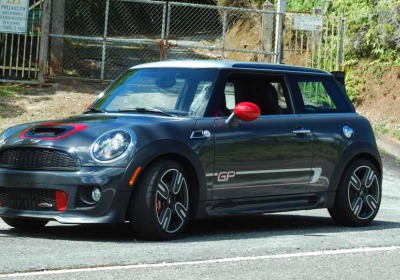2013 Mini John Cooper Works GP drive review
Mon, 11 Feb 2013
Mark Vaughn threw the '13 John Cooper Works GP around Circuito Mallorca a few months back, and the quickest-ever production Mini proved itself to be an excellent track car.
The questions one always asks about a car stuffed full of turbo boost and beefy suspension goodies, however, remained hanging before us: Will it be intolerable on the street? Will it ride like a steel-shod forklift on rough pavement and leap like a hornet-stung mule into the back of a porta-potty truck when the boost comes on? Short answer for the JCW GP: Nope!
The John Cooper Works GP's hood scoop could be described as quasi-functional.
We drove the JCW GP around the narrow, pothole-enhanced roads north of Ponce, Puerto Rico, and all of our dental work is still in place, no Mitsubishi Fusos hauling coffee plants acquired Mini-shaped dents in their bumpers, and no GPs boiled over in 80-degree temperatures. You feel every crack in the asphalt in a GP, sure, but enough edge is taken off the bumps to get you to the office without the sensation that you just crawled out of a garbage can after having been dragged over a few hundred yards of railroad ties.
The Mini John Cooper Works GP is powered by 1.6L Supercharged four pot.
The 211-horse turbocharged N18B16TOP L4 (sibling, or at least first cousin, to the N13 engines used in some versions of the BMW F20 1-series and F30 3-series) delivers gloriously sudden power when the boost comes on; the undersquare (3" bore, 3.4" stroke) N18/N13 needs to be kept under six grand, but this engine doesn't need to be spun to rod-throwingly lunatic levels in order to do its business. Mini gets some bonus points for not yielding to the temptation to over-fartify the exhaust note in this car; it sounds just mean enough but doesn't cross over into bewinged-WRX-with-5"-tailpipe territory.
The Mini John Cooper Works GP sports top-shelf Recaro buckets.
Likewise, the interior bling isn't overdone; the car gets some top-shelf Recaro seats, screaming red seat belts, and a red bar between the rear strut towers— for keeping luggage from whacking the occupants during sudden stops, not for stiffening the chassis.
The JCW GP's interior gets special red stitching.
There's a "1 of 2,000" badge on the dash (500 or so of these cars will be brought over to North America) and some red stitching.
The 2013 Mini John Cooper Works GP proved up to the task of avoiding Puerto Rican canines.
The roads in the hills near Ponce tend to be narrow, studded with serious potholes, and lined with obstacles ranging from Disco Era Econoline vans in mid-engine swap to groups of fearless Caribbean village dogs. We even spotted a couple of mongoose dashing before our GP, and your reviewer's middlin' driving skills were more than sufficient to keep the car out of trouble.
The Mini John Cooper Works GP sports special wheels.jpg
The wheels are updated versions of the ones installed on the '06 Mini John Cooper Works GP, a car that now boasts a tiny but fanatically devoted following.
Building a Mini John Cooper Works clone using aftermarket parts might be more expensive than the factory version.
The Mini folks make an interesting point about the value of the components in this vehicle, just in case some of you are considering buying the regular $30,800 John Cooper Works Mini Hardtop and then applying a healthy dose of aftermarket goodies to build your own GP. Even if you were to skip the stuff like paint and the leather dash, you'd still get pretty close to the sticker price of a GP: $39,950. Not that many Mini shoppers would ever consider doing such a thing with a brand-new car, but it's still worth thinking about.
Mini says that if you buy a John Cooper Works GP, friends come with it.
The Mini folks talk a lot about their cars' quirkiness, how they "come with friends," (your reviewer always hears that line as "buy a Mini and you buy some friends") and a fair helping of similar code phrases orbiting around the image of "the youngish urban types who might lurch into Prius ownership if we don't grab them right quick with our quasi-retro schtick," but that demographic group might just shy away in horror from a car whose engine howls with murderous small-displacement-tortured-with-geological-boost-levels rage when they gas it a bit too hard exiting the Whole Foods parking lot.
The GP has power-to-weight and performance numbers remarkably similar to those of the current Mitsubishi Evo MR, and that car's targeted buyers would vanish into a matter/antimatter fireball if they ever had to share showroom oxygen with Mini's ideal purchasers. Which is too bad, because the GP gives you the all the joyously brutal acceleration and internal-organ-rearranging braking of the Evo and its ilk without the embarrassing sci-fi-movie-meets-the-Pep-Boys looks, at about the same price.
It doesn't have true "go-cart handling" (another phrase much favored by your Mini execs and a term that really shouldn't be applied to any car with a wheel diameter greater than 13— no, make that 12— inches), more like "well-sorted small-car handling," but its grip gets within a few notches of a balls-to-wall race car's while not leaving any parts behind in Puerto Rican potholes. It sports some flashy show-off visual touches yet remains true to the carefully focus-grouped Mini look.
In summary, a two-seat track car that ought to be perfectly happy as a daily commuter.
2013 Mini John Cooper Works GP
On sale: Now
Base price: $39,950
Drivetrain: 1598cc turbocharged I4; 211 hp/206 lb-ft, FWD six-speed manual
Curb weight: 2,772 lbs
0-60 MPH: 5.9 seconds
Fuel Economy (EPA City/Hwy): 26/35
By Murilee Martin

